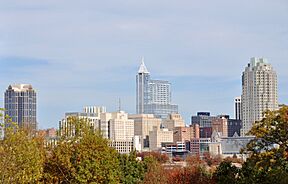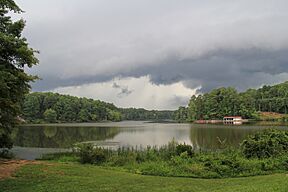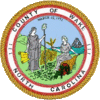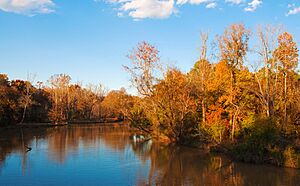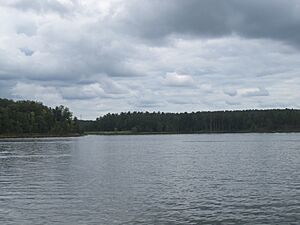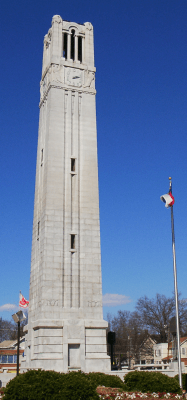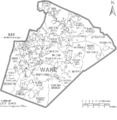Wake County, North Carolina facts for kids
Quick facts for kids
Wake County
|
|||||
|---|---|---|---|---|---|
|
|
|||||
|
|||||

Location within the U.S. state of North Carolina
|
|||||
 North Carolina's location within the U.S. |
|||||
| Country | |||||
| State | |||||
| Founded | 1771 | ||||
| Named for | Margaret Wake | ||||
| Seat | Raleigh | ||||
| Largest community | Raleigh | ||||
| Area | |||||
| • Total | 857.02 sq mi (2,219.7 km2) | ||||
| • Land | 834.59 sq mi (2,161.6 km2) | ||||
| • Water | 22.43 sq mi (58.1 km2) 2.62% | ||||
| Population
(2020)
|
|||||
| • Total | 1,129,410 | ||||
| • Estimate
(2023)
|
1,190,275 |
||||
| • Density | 1,317.834/sq mi (508.819/km2) | ||||
| Time zone | UTC−5 (Eastern) | ||||
| • Summer (DST) | UTC−4 (EDT) | ||||
| Congressional districts | 2nd, 4th, 13th | ||||
Wake County is a county in the state of North Carolina, USA. It is the most populated county in North Carolina. In 2020, over 1.1 million people lived here.
The county seat, or main city, is Raleigh. Raleigh is also the capital city of North Carolina. Other important towns in Wake County include Cary. Wake County is part of the "Research Triangle" area, known for its universities and tech companies.
The county is run by the Wake County Board of Commissioners. Law enforcement is handled by the Wake County Sheriff's Department.
Contents
History of Wake County
Early Beginnings
Long ago, the land that is now Wake County was home to the Tuscarora Native American nation.
How Wake County Was Formed

Wake County was created in 1770. It was made from parts of three other counties: Cumberland, Johnston, and Orange. The first courthouse was in a village called Wake Courthouse, which is now known as Bloomsbury.
Over the years, some parts of Wake County were used to form new counties. This included Franklin County in 1787 and Durham County in 1881 and 1911.
Raleigh Becomes the Capital
For a while after the Revolutionary War, North Carolina did not have a permanent capital city. The state government met in different places. In 1792, a group was chosen to pick a spot for a permanent capital. They chose land owned by Colonel John Hinton at first. But after a meeting at the home of Joel Lane, the vote changed to Lane's land.
Wake County was named after Margaret Wake Tryon, who was the wife of Governor William Tryon. Raleigh was named after Sir Walter Raleigh. He never visited North Carolina but helped start the first English colony in North America on Roanoke Island. Raleigh became both the state capital and the new county seat in 1792.
The Civil War in Wake County
The Battle at Morrisville Station happened from April 13–15, 1865. This was during the American Civil War. It was the last major battle between the armies of General William T. Sherman (Union) and General Joseph E. Johnston (Confederate).
Union forces pushed the Confederates out of Morrisville. The Confederates were trying to move their supplies and wounded soldiers by train. They had to leave many supplies behind. After this battle, General Johnston asked General Sherman to talk about ending the war. They met a few days later to discuss the terms of surrender.
Wake County in Recent Times
In August 2014, the population of Wake County grew to over 1,000,000 people. This shows how much the area has grown!
In 2017 and 2018, officials from Wake and Harnett counties worked together. They used new technology to update the exact line between the counties. This change affected about 130 properties.
Geography and Nature
Wake County covers about 857 square miles (2,220 square kilometers). Most of this area is land, with about 22 square miles (57 square kilometers) being water.
Wake County is in the central part of North Carolina. It's where the rolling hills of the Piedmont meet the flat Atlantic Coastal Plain. This area is called the "fall line." It means you start to see waterfalls in rivers as the land drops towards the coast. The county has gentle hills that slope towards the east.
Waterways and Lakes
Many rivers and lakes are found in Wake County. These include Crabtree Creek, Walnut Creek, and the Neuse River. Important lakes include Lake Crabtree, Lake Johnson, Lake Raleigh, Lake Wheeler, Lake Benson, and Harris Lake. Parts of Falls Lake and Jordan Lake are also in Wake County.
Weather in Wake County
Wake County has a mild subtropical climate. This means spring, fall, and winter are usually pleasant. Summers are typically hot and humid.
In winter, temperatures are often in the 50s °F (10-13 °C) during the day. Nights are usually in the 30s °F (-2-2 °C). Sometimes, it can even get warmer, into the 60s °F (16 °C). Spring and fall days are usually in the 70s °F (21-26 °C). Summer days often reach the upper 80s to low 90s °F (29-35 °C). The rainiest months are July and August.
On average, the county gets about 7 inches (18 cm) of snow each winter. Sometimes, there are ice storms that can cause damage.
Natural Parks and Protected Areas
Wake County has many beautiful natural areas and parks. Some of these include:
- Annie Louise Wilkerson, MD Nature Preserve Park
- Blue Jay Point County Park
- Clemmons Educational State Forest (part)
- Falls Lake State Recreation Area (part)
- Harris Lake County Park
- Hemlock Bluffs Nature Preserve
- JC Raulston Arboretum
- Lake Crabtree County Park
- William B. Umstead State Park
Neighboring Counties
Wake County shares borders with these counties:
- Granville County – to the north
- Franklin County – to the northeast
- Nash County – to the east
- Johnston County – to the southeast
- Harnett County – to the southwest
- Chatham County – to the west
- Durham County – to the northwest
Parks and Fun Activities
State Parks in Wake County
Wake County is home to three state parks:
- Falls Lake State Recreation Area: Located in northern Wake County, it has a large lake and woodlands.
- Jordan Lake State Recreation Area: Partially in Wake County, it's known for its large lake and for being home to bald eagles.
- William B. Umstead State Park: This park is between Raleigh and Cary. It has over 5,500 acres (2,250 hectares) of woodlands.
County Parks and Recreation Centers
There are many parks, swimming pools, and tennis courts in Wake County. There are also over 50 community centers. Famous parks include Pullen Park and Yates Mill Park.
The American Tobacco Trail is a 22-mile (35 km) path for walking and biking. About 15 miles (24 km) of it are in Wake County. The Capital Area Greenway system has over 100 miles (160 km) of paved trails for walking and biking.
People and Population
| Historical population | |||
|---|---|---|---|
| Census | Pop. | %± | |
| 1790 | 10,192 | — | |
| 1800 | 13,437 | 31.8% | |
| 1810 | 17,096 | 27.2% | |
| 1820 | 20,102 | 17.6% | |
| 1830 | 20,398 | 1.5% | |
| 1840 | 21,118 | 3.5% | |
| 1850 | 24,888 | 17.9% | |
| 1860 | 28,627 | 15.0% | |
| 1870 | 35,617 | 24.4% | |
| 1880 | 47,939 | 34.6% | |
| 1890 | 49,207 | 2.6% | |
| 1900 | 54,626 | 11.0% | |
| 1910 | 63,229 | 15.7% | |
| 1920 | 75,155 | 18.9% | |
| 1930 | 94,757 | 26.1% | |
| 1940 | 109,544 | 15.6% | |
| 1950 | 136,450 | 24.6% | |
| 1960 | 169,082 | 23.9% | |
| 1970 | 228,453 | 35.1% | |
| 1980 | 301,327 | 31.9% | |
| 1990 | 423,380 | 40.5% | |
| 2000 | 627,846 | 48.3% | |
| 2010 | 900,993 | 43.5% | |
| 2020 | 1,129,410 | 25.4% | |
| 2023 (est.) | 1,190,275 | 32.1% | |
| U.S. Decennial Census 1790–1960 1900–1990 1990–2000 2010–2020 |
|||
Population in 2020
| Race / Ethnicity (NH = Non-Hispanic) | Pop 2000 | Pop 2010 | Pop 2020 | % 2000 | % 2010 | % 2020 |
|---|---|---|---|---|---|---|
| White alone (NH) | 439,160 | 560,536 | 645,020 | 69.95% | 62.21% | 57.11% |
| Black or African American alone (NH) | 122,648 | 182,793 | 204,535 | 19.53% | 20.29% | 18.11% |
| Native American or Alaska Native alone (NH) | 1,821 | 2,537 | 2,760 | 0.29% | 0.28% | 0.24% |
| Asian alone (NH) | 21,183 | 48,287 | 96,665 | 3.37% | 5.36% | 8.56% |
| Pacific Islander alone (NH) | 178 | 317 | 453 | 0.03% | 0.04% | 0.04% |
| Other Race alone (NH) | 842 | 1,755 | 6,210 | 0.13% | 0.19% | 0.55% |
| Mixed race or Multiracial (NH) | 8,029 | 16,846 | 45,526 | 1.28% | 1.87% | 4.03% |
| Hispanic or Latino (any race) | 33,985 | 87,922 | 128,241 | 5.41% | 9.76% | 11.35% |
| Total | 627,846 | 900,993 | 1,129,410 | 100.00% | 100.00% | 100.00% |
In 2020, Wake County had 1,129,410 people living there. There were 419,361 households and 279,243 families.
Population in 2018
In 2018, the county had about 1,092,776 people. The average household had 2.51 people. About 25.1% of the population was under 18 years old. The median age was 33 years.
Economy and Jobs
Wake County's economy is strongly connected to the Research Triangle Park (RTP). RTP is one of the largest industrial parks in the country. It's a major hub for high-tech and biotech research. More than 160 companies are located there, employing over 50,000 people. Some of the biggest employers include IBM, GlaxoSmithKline, and Cisco Systems.
Wake County also has industries that make things like electrical, medical, and electronic equipment. Food processing and paper products are also important. Farming is still present in rural areas, growing crops like tobacco, cotton, and corn.
Many big companies have their headquarters or major offices in Wake County. SAS Institute, a large software company, is in Cary. Advance Auto Parts, a Fortune 500 retailer, is based in Raleigh. Other companies include Epic Games and Lenovo Group (U.S. headquarters).
In 2007, Forbes magazine said Raleigh and Cary were among the best cities for jobs. They were also ranked as top places for business and careers.
In April 2021, Apple Inc. announced plans to build a large hub in the Wake County part of Research Triangle Park. This project is expected to create over 3,000 new jobs.
Getting Around Wake County
Major Roads
 I-40: This is the main Interstate Highway in the county. It connects to Raleigh-Durham International Airport, Cary, and Raleigh.
I-40: This is the main Interstate Highway in the county. It connects to Raleigh-Durham International Airport, Cary, and Raleigh. I-42
I-42


 I-87 / Future I-87: This highway is still being built. It will connect I-40 to Norfolk, Virginia.
I-87 / Future I-87: This highway is still being built. It will connect I-40 to Norfolk, Virginia. I-440: This road is part of the "Beltline" that goes around central Raleigh.
I-440: This road is part of the "Beltline" that goes around central Raleigh.


 I-540 / NC 540 Toll: This is a partially finished loop connecting towns like Knightdale, Cary, and Apex. Parts of it are toll roads.
I-540 / NC 540 Toll: This is a partially finished loop connecting towns like Knightdale, Cary, and Apex. Parts of it are toll roads. US 1,
US 1,  US 64,
US 64,  US 70,
US 70,  US 264,
US 264,  US 401 are other important U.S. highways.
US 401 are other important U.S. highways.
Bike Routes
Several bike routes pass through Wake County. These include the "Mountain to Sea" North Carolina Bicycle Route 2 and the Maine-to-Florida U.S. Bicycle Route 1.
Transportation Hubs
- Raleigh-Durham International Airport: Located in northwestern Wake County, this airport offers flights to many places. It serves over 14 million passengers each year.
- GoTriangle: This bus system connects different cities in the region, including Raleigh, Durham, and Cary.
- New Hope Valley Railway: A fun, historic railway.
- Raleigh Union Station: A train station in Raleigh.
Education and Learning
Colleges and Universities
Wake County is home to several colleges and universities:
- Meredith College
- North Carolina State University (NCSU)
- Peace College
- Saint Augustine's College
- Shaw University
- Wake Technical Community College
The State Library of North Carolina is also in Raleigh. It helps libraries and people across the state.
Schools for Kids
Public education in Wake County is managed by the Wake County Public School System. It is one of the largest school districts in the United States, with over 155,000 students. There are many high schools, middle schools, and elementary schools. The county also has charter schools and private schools.
Libraries for Everyone
The Wake County Public Library system has 22 branches. These libraries offer books, magazines, audiobooks, and e-books. You can find libraries in Raleigh, Cary, Apex, Holly Springs, and many other towns.
Healthcare Services
Wake County has three main healthcare systems:
- WakeMed Health & Hospitals
- UNC Rex Healthcare
- Duke Raleigh Hospital
WakeMed has a main hospital in Raleigh and other community hospitals and health centers throughout the county.
Culture and Arts
Museums to Explore
Live Performances
Wake County has many places to enjoy live music and shows. These include large outdoor venues like Coastal Credit Union Music Park and Red Hat Amphitheater. There are also smaller theaters and clubs.
The Duke Energy Center for the Performing Arts in Raleigh has several theaters for different types of shows. Other places for theater include the Raleigh Little Theatre and Theatre in the Park. Local colleges and universities also host performances.
Wake County is home to professional arts groups like the North Carolina Symphony and the Carolina Ballet.
Visual Arts
The North Carolina Museum of Art has a large collection of art. It includes American, European, African, and ancient art. The museum's outdoor park is one of the biggest art parks in the country.
The Contemporary Art Museum of Raleigh in downtown Raleigh shows new and modern art.
Sports and Teams
Professional Sports
The National Hockey League's Carolina Hurricanes hockey team plays in Raleigh. Their home arena is the Lenovo Center. The Hurricanes won the Stanley Cup in 2006.
North Carolina FC (soccer) and the North Carolina Courage (women's soccer) play in Cary at the WakeMed Soccer Park. The Courage team has won national championships.
The Carolina Mudcats are a minor league baseball team. Their ballpark is in Zebulon.
Wake County also hosts the PGA Nationwide Tour golf tournament, now called the UNC Health Championship.
College Sports
North Carolina State University (NCSU) is a member of the Atlantic Coast Conference (ACC). Their basketball games are played at the PNC Arena, and football games at Carter–Finley Stadium.
Other colleges in Wake County also have sports teams, including St. Augustine's College, Meredith College, and Shaw University.
Amateur Sports
Wake County has many amateur sports groups. These include the Raleigh Cú Chulainn, which has Hurling and Gaelic football teams. The North Carolina Tigers play Australian Rules football. The Carolina Rollergirls are an all-women flat-track roller derby team.
The USA Baseball National Training Complex is located in Cary.
Communities in Wake County
Cities
Towns
Townships
- Bartons Creek
- Buckhorn
- Cary
- Cedar Fork
- Holly Springs
- House Creek
- Leesville
- Little River
- Marks Creek
- Meredith
- Middle Creek
- Neuse
- New Light
- Panther Branch
- Raleigh
- St. Mary's
- St. Matthew's
- Swift Creek
- Wake Forest
- White Oak
Unincorporated Communities
- Asbury
- Auburn
- Banks
- Barham
- Bayleaf
- Bonsal
- Carpenter
- Clegg
- Eagle Rock
- Falls
- Feltonville
- Five Points
- Forestville
- Fowlers Crossroads
- Friendship
- Green Level
- Holland
- Hollemans Crossroads
- Hopkins
- Kennebec
- Lassiter
- Leesville
- Lizard Lick
- Macks Village
- McCullers
- McCullers Crossroads
- Medfield
- Mount Pleasant
- Neuse
- New Hill
- New Hope
- New Light
- Purnell
- Riley Hill
- Sandy Plain
- Shotwell
- Six Forks
- Stony Hill
- Wake Crossroads
- Walkers Crossroads
- Westover
- Wilbon
- Williams Crossroads
- Willow Spring
- Wyatt
Images for kids
See also
 In Spanish: Condado de Wake para niños
In Spanish: Condado de Wake para niños


